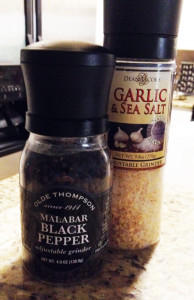
Salt and Pepper. They stand tall at every table in America.
So I was thinking I would like to do a little research about their origins and by the way…. what exactly is pepper? Off the top of your head…. do you know?
NO CHEF!
Without any research I would say there must be a pepper plant somewhere….
Let’s ask Wiki:
“Black Pepper is a flowering vine in the piperaceae family, cultivated for its’ fruit which is usually dried and used as a spice or seasoning”.
Aaaah. Did you catch that? We’re calling peppercorns ‘fruit’. Interesting. None of us would call pepper a fruit. And when they talk about black pepper, they refer to it as – cooked and dried unripe fruit, green pepper – dried unripe fruit and white pepper – ripe fruit seeds.
Where does pepper come from, you might wonder….?
YES CHEF! TELL US!
Black Pepper is ‘native’ to south India. However, as of 2008 34% of the world’s pepper comes from Vietnam.
So that’s its‘ history.
Salt is going to be way more complicated… but here goes!
I’m sure we can all guess that salt (in days past) was used as currency, and to preserve food. I have personally found it really helpful, to cook food, and I’m not talking about salting your food. When I was in Napoli, they served a salt encrusted fish. Amazingly enough, although cooked in packed salt, the fish was moist, tender and not overly salty.
Salt goes back 6,000 years or so. People in both Romania and China were boiling spring water to get the salts out. In some parts of the world they built salt roads. Yech. Can you imagine being in Egypt on a camel crossing the Sahara and all you can taste is salt that comes up from the road? lol
In today’s world, we think of ‘salt mines’ as a way we get our salt. What is salt?
SODIUM CHLORIDE, CHEF?
Bingo. You’ve got it. I think that’s something we all learned in school. Wiki says that ‘Common salt is a mineral substance composed primarily of sodium chloride’. And we know of all kinds: Sea Salt, Rock Salt, Kosher Salt, Himalayan Salt…
You know that regular salt is highly refined salt and sea salt comes from the sea. Right? Kosher salt obviously has something to do with religion….. The jews used it to soak up the blood from meat. Kosher salt has got larger flakes and it’s easier to work with when you’re sprinkling it over food. Also, unlike table salt, it has way less (if any) iodine. That’s important to know if you’re allergic to iodine! I actually have someone I cook for that has that very problem. Can you imagine not being able to eat anything that has anything other than kosher or plain table salt on the label?
And if you have ever heard of Maldon Salt, (really good, imported from the UK and used at Mozza in Los Angeles for example) … that’s what they use to give you a salted caramel. The salt pops in your mouth! Unlike Maldon, Kosher Salt (while still a bigger crystal) will dissolve in what you’re cooking and give you little or no difference than regular salt, in terms of flavor. Most people use Table Salt (except in my world), because to me, table salt leaves a bad after taste. So I don’t use it.
People who haven’t had it often ask me about Himalayan Salt.
Well, it’s a rock salt from Pakistan.
According to AuthorityNutrition, “It is mined from the Khewra Salt Mine, the second largest salt mine in the world.
Himalayan salt often contains trace amounts of iron oxide (rust), which gives it a pink color.
It does contain small amounts of calcium, iron, potassium and magnesium. It also contains slightly lower amounts of sodium than regular salt”.
Some people say there’s no difference between salts, in flavor. But I don’t think that’s true. Himalayan Salt is spicy. Do a taste test and see if you agree with me!
People in China have other uses for it. According to Wiki: “Salt lamp is a lamp carved from a larger salt crystal, with a bulb or a candle inside. Large crystal rocks, mined in Europe and Asia, are also used as salt lamps”.
Onto Sea Salt. It’s just salt from the ocean. But here’s what Authority Nutrition has to say about that:
“Depending on where it is harvested and how it was processed, it usually does contain some amount of trace minerals like potassium, iron and zinc.
The darker the sea salt, the higher its concentration of “impurities” and trace nutrients will be. However, keep in mind that due to the pollution of oceans, sea salt can also contain trace amounts of heavy metals like lead”.
LEAD? SEA SALT? DID THEY SAY LEAD?
Yes. They did say lead.
I think everything in moderation is good. Yes?
YES CHEF!
So let me tell you how and why I use salt and pepper as seasonings….. Aaah. This blog is already too long.
I’ll tell you in my next blog!
Happy Eating,
Chef Marian